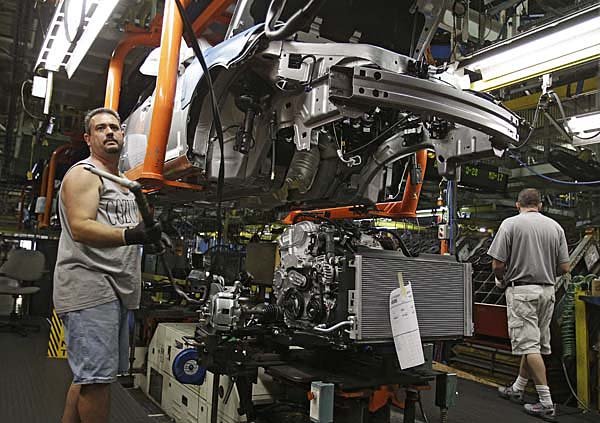WASHINGTON — Orders to U.S. factories for big ticket manufactured goods fell in June as demand for commercial aircraft fell. But businesses increased spending on capital goods for a second-straight month, a sign that manufacturing continues to help keep the economic recovery afloat.
Demand for durable goods dropped 1 percent last month to a seasonally adjusted $190.5 billion, the Commerce Department said Wednesday. It was the second-straight monthly decline and the largest drop since August 2009.
The gains in business spending will partially compensate for the slowdown in consumer spending that is causing the world’s largest economy to cool heading into the second half of the year.
“Businesses are, in general, still investing,” said Russell Price, a senior economist at Ameriprise Financial Inc. in Detroit, who projected a decline in durable-goods orders excluding transportation. “If they want to compete, they have to invest. The recovery is continuing.”
Orders for commercial aircraft fell 25.6 percent in June, although seasonal adjustments kept the report from reflecting a strong month for Boeing. Without the volatile transportation sector, orders fell by 0.6 percent.
Manufacturing has helped drive growth during the early stages of the recovery. A slowdown in orders could be a sign that the recovery is losing strength.
Economists said the June report wasn’t as bad as the headline number. Business spending for machinery and equipment edged up 0.6 percent, after a 4.6 percent surge in May. And positive earnings reports could lead to further gains in net income, an encouraging sign for growth in the rest of the year.
“Overall, we have no doubt this data will play badly in the markets, but it isn’t actually that terrible,” said Paul Ashworth, a senior U.S. economist with Capital Economics. “The bottom line is that it shows business investment had a very strong second quarter and, although the recovery in manufacturing may be losing a little momentum, it is hardly collapsing.”
June’s overall durable goods orders were 16.5 percent higher than the seasonally adjusted $176 billion in orders from a year ago, when the economic recovery had yet to take hold. But they were below the pre-recession peak of $229.5 billion in July 2007.
Even the commercial-aircraft figures are open to interpretation. The Commerce Department reported that orders surged in April, then fell in May and tumbled further in June.
But Boeing, the largest U.S. manufacturer of planes, booked orders for 49 airplanes last month after only five orders in May and 34 in April, according to the company’s website.
One reason for a discrepancy could be that the government seasonally adjusts its figures. It expects a high volume of aircraft orders during the summer months. So even a large number of orders from Boeing could have little impact on the durable goods figures if the commercial-aircraft orders fell short of expectations.
“Once Boeing’s orders were seasonally adjusted in the official figures, they were always going to look a lot less impressive,” said Ashworth.
Durable goods are those expected to last three or more years.
Last month’s decline hit most major industries, including machinery, primary metals and electronics. Motor vehicles, electrical equipment and appliances were among the few bright spots.
Consumers and businesses are reining in spending as the economy sputters. High unemployment and Europe’s economic instability weighed on them in June.
In a separate report, the Federal Reserve said Wednesday that the pace of economic activity has slowed or held steady in parts of the country.
Of the 12 regions tracked by the Fed, the survey said that growth held steady in Cleveland and Kansas City, but slowed in Atlanta and Chicago. Economic activity elsewhere was described as modest.
In the St. Louis region, which includes Arkansas, the Fed reported continued improvement in manufacturing, auto sales and home sales.
Year-to-date home sales were up 3 percent in Memphis, 12 percent in St. Louis and 19 percent in Little Rock, the Fed report said.
High unemployment, cautious consumers and businesses, an ailing housing market and an edgy Wall Street have kept the recovery from gaining strength.
Manufacturing expanded in most regions. However, half of them - New York, Cleveland, Kansas City, Chicago, Atlanta and Richmond, Va. - reported that activity had “slowed” or “leveled off.” Steel production declined in both Chicago and Cleveland.
Retailers reported sales gains, although merchants in some places said shoppers focused on buying “necessities.” Sales of big-ticket goods were slower. In fact, reports across most regions found that auto sales had declined.
The housing market turned more sluggish after homebuyer tax credits expired in April. Commercial real estate businesses continued to “struggle” across all 12 regions, the survey said.
The findings will figure into deliberations when Fed Chairman Ben Bernanke and his colleagues meet next on Aug. 10. The Fed has signaled that it will hold rates at record lows at that time and probably well into next year to help energize the recovery.
Information for this article was contributed by Daniel Wagner and Jeannine Aversa of The Associated Press and by Timothy R. Homan of Bloomberg News.
Business, Pages 23 on 07/29/2010

